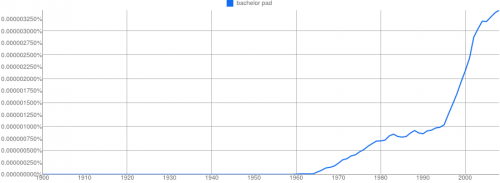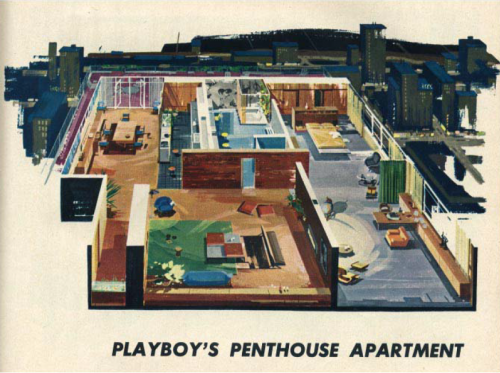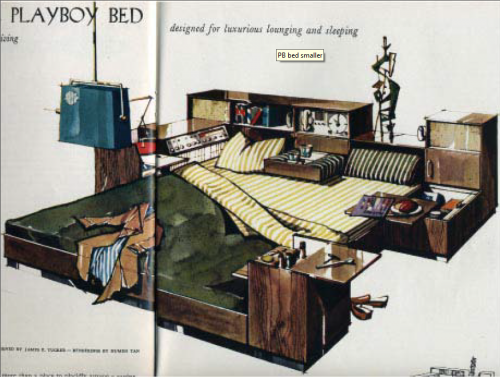For the last week of December, we’re re-posting some of our favorite posts from 2012. Originally cross-posted at Inequality by Interior Design.
There is not actually a great deal of literature on “man caves,” “man dens,” and the like–save for some anthropological and archeological work using the term a bit differently. There is, however, a substantial body of literature dealing with bachelor pads. The “bachelor pad” is a term that emerged in the 1960s. It was a style of masculinizing domestic spaces heavily influenced by “gentlemen’s” magazines like Esquire and Playboy. Originally referred to as “bachelor apartments,” “bachelor pad” was coined in an article in the Chicago Tribune, and by 1964 it appeared in the New York Times and Playboy as well.

It’s somewhat ironic that the “bachelor pad” came into the American cultural consciousness at a time when the median age at first marriage was at a historic low (20.3 for women and 22.8 for men). So, the term came into usage at a time when heterosexual marriage was in vogue. Why then? Another ironic twist is that while the term has only become more popular since it was introduced, “bachelorette pad” never took off–despite the interesting finding that women live alone in larger numbers than do men. I think these two paradoxes substantiate a fundamental truth about the bachelor pad–it has always been more myth than reality (see here, here, here, here, and here).
The gendering of domestic space had been a persistent dilemma since the spheres were separated in the first place. Few men were ever able to afford the lavish, futuristic and hedonistic “pads” advertised in Esquireand Playboy. But they did want to look at them in magazines.
A small body of literature on bachelor pads finds that they played a significant role in producing a new masculinity over the course of the 21st century. As Bill Ogersby puts it, “A place where men could luxuriate in a milieu of hedonistic pleasure, the bachelor pad was the spatial manifestation of a consuming masculine subject that became increasingly pervasive amid the consumer boom of the 1950s and 1960s” (here). The really interesting thing is that few men were actually able to luxuriate in these environments. Yet Playboy — along with a host of copycat magazines — spent a great deal of money, time, and effort perpetuating a lifestyle in which few men engaged. Indeed, outside of James Bond movies and the Playboy Mansion, I wonder how many actual bachelor pads exist or ever existed.
In the 1950s — despite a transition into consumer culture — consumption was regarded as a feminine practice and pursuit. Bachelor pads — and the magazines that sold the images of these domestic spaces to men around the country — helped men bridge this gap. More than a few have noted the importance of Playboy’s (hetero)sexual content in helping to sell consumption to American men. Barbara Ehrenreich said it this way: “The breasts and bottoms were necessary not just to sell the magazine, but to protect it” (here). Additionally, the masculinization of domestic space took many forms in early depictions of bachelor pads with ostentatious gadgetry of all types, beds with enough compartments and features to be comparable to Swiss Army knives, and each room designed in anticipation of heterosexual conquest at a moment’s notice.
Paradoxically, bachelor pads seem to have been produced to sell men thehistorically “feminized” activity of consumption.
I’m guessing that many of the “man caves” I’ll see in my research wouldn’t necessarily fit the image most of us conjure in our minds. But the ways men with caves talk about them are replete with images not yet fully realized by men who are most often economically incapable of architecturally articulating domestic spaces without which they may never feel “at home.”
———————
Tristan Bridges is a sociologist of gender and sexuality. He starts as an Assistant Professor of Sociology at the College at Brockport (SUNY) in the fall of 2012. He is currently studying heterosexual couples with “man caves” in their homes. Tristan blogs about some of this research and more at Inequality by (Interior) Design. You can follow him on twitter @tristanbphd.
Lisa Wade, PhD is an Associate Professor at Tulane University. She is the author of American Hookup, a book about college sexual culture; a textbook about gender; and a forthcoming introductory text: Terrible Magnificent Sociology. You can follow her on Twitter and Instagram.



Comments 36
Ed Hoover — April 17, 2012
Correct me if I'm wrong, but isn't a "man cave" usually used to signify a personal, masculine place carved out of a presumably feminized shared space? As in, a man and a woman share a home, and she decorates it, so it's overly "feminized," and so the man needs a place where he can "be a man" or somesuch. Whereas a bachelor pad was/is a space inhabited solely by a single (hetero) man.
So they're probably two distinct things.
The Bachelor Pad: Myths and Reality « Inequality by (Interior) Design — April 17, 2012
[...] Cross-posted at Sociological Images Share this:Like this:LikeBe the first to like this [...]
Anonymous — April 17, 2012
This is very interesting and a nice change from a lot of the typical posts here. I'll be looking at your blog.
WG — April 17, 2012
"I think these two paradoxes substantiate a fundamental truth about the bachelor pad–it has always been more myth than reality..."
I like to read about Frank Lloyd Wright houses and hope to one day live in one. I aspire to be a grand French chef and read various books on the matter. Does my desire equate to myth? The likelihood of either of these things happening is remote, but myth?
Jennifer Chadwell — April 17, 2012
You might be interested in the "bachelor cottage" that was shared by Mortimer and Eugene in Charles Dickens's _Our Mutual Friend_. Dickens is credited with coining the term and it apparently influenced Victorian culture.
Jade — April 17, 2012
Happy to see the author is working on man caves, because the whole time I was reading it, all I could think was "what about the man caves? are those real?"
Valerie — April 17, 2012
The last photo reminds me a lot of the 1970s Barbie Townhouse I had as a kid. http://www.retroist.com/2009/07/01/barbie%E2%80%99s-townhouse-then-and-now/
Matthew Parslow — April 17, 2012
Tristan could you please clarify the enourmous run on sentence at the end of this post? The meaning is unclear at best
Link Roundup, Outdoor Fucking Starts Today Edition | No, Seriously, What About Teh Menz? — May 1, 2012
[...] bachelor pad, because This Is A Manly Man Thing For Men (even though it’s traditionally girly) is not new [...]
Link Roundup, Outdoor Fucking Starts Today Edition — The Good Men Project — May 27, 2012
[...] bachelor pad, because This Is A Manly Man Thing For Men (even though it’s traditionally girly) is not new [...]
AcademicLurker — January 1, 2013
It's interesting that the era of Playboy seems to have begun right around the final death of the "club" as an archetypical masculine space. The Playboy Club is a kind of mutated version of the older clubs.
Am I imagining things? Were clubs already gone well before the 50s?
clarionbody — April 25, 2020
In the 1950s — despite a transition into consumer culture — consumption was regarded as a feminine practice and pursuit. Bachelor pads — and the magazines that sold the images of these domestic spaces to men around the country — helped men bridge this gap. More than a few have noted the importance of Playboy’s (happy wheels)sexual content in helping to sell consumption to American men. Barbara Ehrenreich said it this way: “The breasts and bottoms were necessary not just to sell the magazine, but to protect it” (here). Additionally, the masculinization of domestic space took many forms in early depictions of bachelor pads with ostentatious gadgetry of all types, beds with enough compartments and features to be comparable to Swiss Army knives, and each room designed in anticipation of heterosexual conquest at a moment’s notice.
Gladys Nelson — July 24, 2020
Beside these 6 reasons for pre order to get the best services when needed.Thanks for exploring details of your services.
Luke — May 4, 2021
PerthIsOk is a travel guide blog website and covers all famous tourist places, things to do, places to drink, places to eat, places where to go and best places to see in Perth , Western Australia.
Vindousis gadayeneba — August 7, 2021
This is very interesting and a ვინდოუსის გადაყენება nice change from a lot of the typical posts here. I'll be looking at your blog.
dzwonkimp3 — July 8, 2022
Przedstawiamy Ci stronę internetową z tysiącami niesamowitych dzwonków, które czekają na Ciebie.
margret — October 25, 2022
That is very good information abc
Jikop — February 1, 2023
Thanks! The updated post gives good information that I enjoyed reading.
This article will bring you many cool things to make the most of how to screenshot on mac.
David worner — May 19, 2023
In addition to the import duty, there may be other taxes and fees associated with importing a car into the United States. One such fee is the Merchandise Processing Fee (MPF), which is a flat rate charged by the CBP for processing the goods.
willam son — May 19, 2023
Furthermore, individual states may impose their own taxes and fees on imported vehicles. These can include sales tax, registration fees, and any applicable emissions or safety inspections. The specific rates and requirements vary from state to state, so it is essential to research and understand the regulations in the particular state where the car will be registered https://www.youtube.com/watch?v=Qt34faGkT_s
run away 3D — May 21, 2023
I had a lot of harvest after seeing this post of yours! Before, I used to play games run 3, this is a fun game for entertainment, but now I will follow you, read your articles will have more knowledge.
Allen — July 3, 2024
Capitan Plumber offers swift and reliable emergency plumbing service. Available 24/7, their experienced team tackles urgent plumbing issues such as burst pipes, clogged drains, and water heater failures with efficiency and professionalism. Committed to customer satisfaction, Capitan Plumber ensures prompt response times and effective solutions to restore your plumbing system quickly and minimize damage to your property.